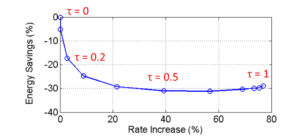Decoding-Energy-Rate-Distortion Optimization (DERDO) for HEVC Video Coding
On this webpage, an HEVC encoder for generating decoding energy saving bit streams can be downloaded. The code is based on HM-14.0 and freely available for personal use (under the GNU-GPL-license). It can be compiled for Windows as well as for Linux. Read the README_DERDO.txt for more information.
Next to the classic QP value, which is used to control the visual quality of the output bit stream, a new variable t can be chosen to control the rate-energy trade-off. t=0 means classic RDO, t=1 means pure decoding-energy-distortion optimization (without considering the rate), values in between can be used to optimize both rate and energy at the same time.
As a result, if rate increases are acceptable, decoding energy can be saved which is especially beneficial for mobile applications.
For more details, please read the following publications:
C. Herglotz, M. Bader, K. Fischer, and A. Kaup, “Decoding-Energy Optimal Video Encoding for x265”, Proc. Proc. IEEE 22nd International Workshop on Multimedia Signal Processing, Sep 2020.
C. Herglotz, A. Heindel, and A. Kaup, “Decoding-energy-rate-distortion optimization for video coding”, IEEE Transactions on Circuits and Systems for Video Technology, vol. 29, pages: 171-182, Jan 2019.
C. Herglotz, D. Springer, M. Reichenbach, B. Stabernack, and A. Kaup, “Modeling the energy consumption of the HEVC decoding process”, IEEE Transactions on Circuits and Systems for Video Technology, vol. 28, pages: 217-229, Jan 2018.
C. Herglotz, “Energy Efficient Video Decoding”, Verlag Dr. Hut, ISBN 978-3-8439-3461-9, 2018.


